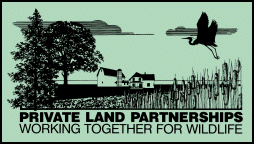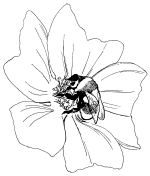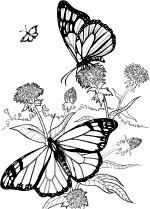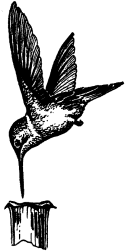 |
|
SPECIAL FEATURE
GARDENS
|
 Besides
adding beauty to the landscape,
gardens that are creatively designed and well-tended can increase the value of property.
Some gardens provide food for the table and others furnish cut flowers for indoor
enjoyment. On larger properties these special feature gardens break up the monotony of
lawn and reduce mowing time. Blending your garden into the surrounding landscape will also
help to minimize habitat fragmentation
effects. Besides
adding beauty to the landscape,
gardens that are creatively designed and well-tended can increase the value of property.
Some gardens provide food for the table and others furnish cut flowers for indoor
enjoyment. On larger properties these special feature gardens break up the monotony of
lawn and reduce mowing time. Blending your garden into the surrounding landscape will also
help to minimize habitat fragmentation
effects.
If you do not own property, you can still enjoy a small-scale garden by arranging
planters and potted flowers on the balcony or deck of your apartment, townhouse, or
condominium. Specialty gardens attract certain kinds of wildlife, which serve to enhance
viewing pleasure. Butterfly, hummingbird, and native prairie gardens are well suited
to this purpose. This chapter will offer suggestions on how to create them.
Butterfly Gardens
 North America is home to more than 700 species of butterflies. At
least 200 of them occur in Michigan and the Midwest including swallowtails, skippers,
satyrs, sulphurs, and cabbage butterflies along with the monarch, painted lady, comma,
red-spotted purple, and red admiral. Adult butterflies are most attracted to red, yellow,
orange, pink, and purple flowers that grow in sunny locations and that offer an easy
source of nectar. Butterfly caterpillars will use at least 175 kinds of Midwest plants,
nearly 50 of which are also excellent for attracting bees. Several kinds of moths,
including hummingbird clearwings, night- and day-flying sphinx species, prometheas, and
cecropias, are also regularly attracted to butterfly gardens. North America is home to more than 700 species of butterflies. At
least 200 of them occur in Michigan and the Midwest including swallowtails, skippers,
satyrs, sulphurs, and cabbage butterflies along with the monarch, painted lady, comma,
red-spotted purple, and red admiral. Adult butterflies are most attracted to red, yellow,
orange, pink, and purple flowers that grow in sunny locations and that offer an easy
source of nectar. Butterfly caterpillars will use at least 175 kinds of Midwest plants,
nearly 50 of which are also excellent for attracting bees. Several kinds of moths,
including hummingbird clearwings, night- and day-flying sphinx species, prometheas, and
cecropias, are also regularly attracted to butterfly gardens.
A butterfly garden can quickly become the prize feature of your yard. Options include
developing the garden around a theme like native prairie wildflowers or native woodland
wildflowers. There are four key factors to creating a successful butterfly garden: (1)
location, (2) plant composition/nectar sources for adult butterflies, (3) caterpillar
habitat, and (4) avoiding insecticide
use.
- Locate the garden in a spot that facilitates maximum viewing opportunities. The best
location is one that receives sun from mid-morning to mid-afternoon because adults
generally feed only in the sun. If sunny spots are limited in your yard, consider planting
a small area of your vegetable garden to herbs. Many of the best bee and butterfly plants
are herbs, including borage, hyssop, lavender, lovage, lemon balm, sweet marjoram,
rosemary, sage, dill, winter savory, parsley, thyme, and the mints.
- Plant perennial plants that
provide excellent sources of nectar. Perennials will lessen your overall cost as they do
not need to be replaced each year. When choosing plants, consider their blooming season,
and select some that bloom early and others that do not bloom until late summer or fall.
However, for earliest results and to add diversity to the garden, plant a few annual flowers. Also consider the mature
height of plants and place the taller plants toward the back and work down in height
toward the front. For open gardens that will be seen from all sides, establish the tallest
plants in the center and work downward with the smallest plants at the edge. If you are
using climbing plants be sure to use a climbing structure such as a lattice, fence, or
building for backdrop.
Plants with a flat-topped towering head, like stiff goldenrod and zinnias, are excellent
butterfly plants because the nectar is richer and more easily accessible. See the
accompanying table for a list of plants that will provide good to
excellent sources of nectar for butterflies, bees, and moths. Latin names are included to
help you find stock at nurseries and garden centers.
- Providing habitat for caterpillars as well as adult butterflies is essential to a
successful butterfly garden. Most butterfly caterpillars do not cause the leaf damage
associated with moth caterpillars. Oaks, aspens, birches, boxelders, and spice bushes can
provide the feeding habitat that butterfly caterpillars need. Some species feed
specifically on certain plants. For example, monarchs use milkweed for both stages of life
--adults visit the flowers for nectar and caterpillars feed on the leaves. The larvae of
mourning cloaks eat nettles, and black swallowtails feed on parsley.
- Most insecticides are lethal to butterflies in both larvae and adult stages. Avoid use
of insecticides in or near the butterfly garden and on key caterpillar habitat. Pesticide use has had a major impact
on butterfly numbers in recent years.
Hummingbird Gardens
 Hummingbirds pollinate more than 160 native North American
plants. Because of their extremely high metabolism, hummingbirds consume daily up to
one-half their body weight in food and as much as eight times their body weight in fluids.
Besides feeding on flower nectar, the ruby-throated hummingbird (the only hummingbird
species found in Michigan) also eats small insects. Usually attracted to red, tubular
flowers, hummingbirds also use a wide variety of other flowers. Thus, you can add both
diversity and color to your yard while providing excellent sources of nectar and small
insects for hummingbirds. Incidentally, because orioles use many of the same plants as
hummingbirds, your hummingbird garden may provide additional habitat for them and increase
your viewing pleasure. Hummingbirds pollinate more than 160 native North American
plants. Because of their extremely high metabolism, hummingbirds consume daily up to
one-half their body weight in food and as much as eight times their body weight in fluids.
Besides feeding on flower nectar, the ruby-throated hummingbird (the only hummingbird
species found in Michigan) also eats small insects. Usually attracted to red, tubular
flowers, hummingbirds also use a wide variety of other flowers. Thus, you can add both
diversity and color to your yard while providing excellent sources of nectar and small
insects for hummingbirds. Incidentally, because orioles use many of the same plants as
hummingbirds, your hummingbird garden may provide additional habitat for them and increase
your viewing pleasure.
Unlike butterflies, hummingbirds find sources of food regardless of sun or shade.
However, the plants themselves can have specific sunlight requirements. So, when planning
the location of your hummingbird garden, consider the sunlight requirements or limitations
of the plants you wish to highlight there. You may also want to consider visibillity.
Because hummingbirds are highly territorial, you might want to locate plants throughout
your yard, in addition to the specialized garden.
You may also want to supplement natural nectar with hummingbird feeders near the garden
and around the house. Place feeders in the shade and change the mixture of one part sugar
(do not use honey) to four parts boiling water every three to five days. Cool the mixture
before filling the feeder, and store the excess in the refrigerator. If the mixture in the
feeder has spoiled (a black fungus or very cloudy water are clues), clean it with a small
amount of vinegar mixed with water, then allow to dry thoroughly before refilling. Because
they are migratory species, you only have to keep the sugar solution available from April
to September.
In addition to sunlight requirements, be aware of other characteristics of your plant
choices. Trumpet creeper, for example, is an attractive plant to hummingbirds, but it
requires a fence or other structure on which to climb. Place vines and shrubs to the back,
working down in height toward the front of the garden. Spread your blooming season as much
as possible. Adding a few annuals to the variety of early- to late-blooming perennials
will give the garden a head start. Refer to the accompanying list of plants that will
provide both nectar and insects for hummingbirds. Also, realize insecticides not only kill
the small insects that hummingbirds use for food, but large doses of insecticides can be
directly lethal to the birds themselves.
Native Prairie Gardens
Native prairie grasses and wildflowers are a shrinking resource in Michigan, and they
attract a large number of wildlife species. In fact, there are many species that can only
survive on native grasses and wildflowers. Wildlife benefit most when the mixture of warm
season grasses and wildflowers occurs in stands of 40 acres or more. However, even small
plantings in backyard gardens can help wildlife and are also attractive. Native prairie
gardens, as well as the other gardens mentioned above, reduce mowing time and add visual
enjoyment, even in winter as the grasses stand up to snow. Some wildflowers, such as
coreopsis, provide winter seed for goldfinches and other birds.
Because most native grasses and wildflowers do best on upland sites, locate this garden
in a sunny to partly shaded, well-drained location. The accompanying panel is a list of
good plants to consider. If the site you have in mind is moist, big bluestem and
switchgrass will likely establish without problems but you might also want to add prairie
and curly dock, swamp milkweed, native impatiens, sedges, and mints. A nursery expert
should be able to help you with your plant selections.
Plant Species for Prairie Gardens
|
| Common Name |
Scientific Name |
Type |
Height |
Blooming Season |
| Big bluestem |
Andropogon gerardii |
G |
3-6 ft |
|
| Indian grass |
Sorghastrum nutans |
G |
3-5 ft |
|
| Little bluestem |
Schizachyrium scoparium |
G |
2-3 ft |
|
| Switchgrass |
Panicum virgatum |
G |
3-5 ft |
|
| American columbine |
Aquilega canadensis |
P |
1-2 ft |
May-June |
| Black-eyed Susan |
Rudbeckia hirta |
P |
1-3 ft |
June-Aug. |
| Gray-headed prairie coneflower |
Ratibida pinnata |
P |
3-5 ft |
July-Sept. |
| Maximillian sunflower |
Helianthus maximilliani |
P |
5 ft |
Aug.-Oct. |
| New England aster |
Aster nova angliae |
P |
1-4 ft |
Sept.-Oct. |
| Prairie blazing star |
Liatrus pycnostachya |
P |
4 ft |
August |
| Prairie coreopsis |
Coreopsis palmata |
P |
1-3 ft |
July |
| Prairie dock |
Silphium terebinthinaceum |
P |
2-6 ft |
Aug.-Sept. |
| Prairie milkweed |
Asclepias sullivanti |
P |
2 ft |
June-July |
| Purple coneflower |
Echinacea purpurea |
P |
2-4 ft |
July-Aug. |
| Wild bergamot |
Monarda fistulosa |
P |
2 ft |
July-Aug. |
| Wild indigo |
Baptisia tincitoria |
P |
3 ft |
June-July |
| Yarrow |
Achilea millefolium |
P |
2 ft |
June-Aug. |
| G = Grass; P = Perennial |
|
|
| Common Name |
Scientific Name |
Type |
Origin |
Sunlight |
B/H |
Height |
Blooming Season |
| American columbine |
Aquilega canadensis |
P |
native |
F/P |
B/H |
1-2 ft |
May-June |
| Bee Balm |
Monarda didyma |
P |
native |
F/P |
H |
3 ft |
June-July |
| Blazing Star |
Liatrus spp. |
P |
native |
F/P |
B/H |
2-4 ft |
July-Sept. |
| Boneset |
Eupatorium perfoliatum |
P |
native |
F/P |
B |
3-4 ft |
July-Aug. |
| Butterflybush |
Buddleia davidii |
P |
exotic |
F/P |
B |
3-8 ft* |
June-Aug. |
| Butterflyweed |
Asclepias tuberosa |
P |
native |
F/P |
B |
2-3 ft |
July-Aug. |
| Cardinal flower |
Lobelia cardinalis |
P |
native |
F/P |
H |
3 ft |
July-Sept. |
| Coral bells |
Heuchera sanguinea |
P |
exotic |
F/P |
H |
2.5 ft |
May-July |
| Coralberry |
Symphoricarpos orbiculatus |
S |
native |
F/P |
B/H |
3 ft |
|
| Fireweed |
Epilobium angustifolium |
P |
native |
F/P |
B/H |
2-4 ft |
July-Aug. |
| Foxglove (Gerardia) |
Agalinis pediculana |
P |
native |
F/P |
H |
3-5 ft |
June-July |
| Gaillardia (firewheel) |
Gaillardia pulchella |
P |
native |
F |
B/H |
3 ft |
June-Aug. |
| Hollyhock |
Althaea rosa |
P |
native |
F/P |
B/H |
5-8 ft |
June-Aug. |
| Joe-pye-weed |
Eupatorium purpureum |
P |
native |
F/P |
B |
2-6 ft |
July-Sept. |
| Leadplant |
Amorpha canescens |
P |
native |
F |
B/H |
2-4 ft |
June-July |
| Lupine |
Lupinus perennis |
P |
native |
F/P |
B/H |
2 ft |
June-July |
| Maximillian sunflower |
Helianthus maximiliani |
P |
native |
F |
B/H |
5 ft |
Aug.-Sep. |
| Narrowleaf meadowsweet |
Spirea alba |
S |
native |
F |
B/H |
4 ft |
June-July |
| Oxeye sunflower |
Heliopsis helianthoides |
P |
native |
F |
B/H |
2.5-3 ft |
July-Sept. |
| Purple conefower |
Echinacea purpurea |
P |
native |
F/P |
B/H |
2-4 ft |
July-Aug. |
| Scarlet petunia |
Petunia spp. |
A |
exotic |
F/P |
H |
1 ft |
through summer |
| Scarlet sage |
Salvia spendens |
A |
exotic |
F/P |
H |
2.5 ft |
until frost |
| Swamp milkweed |
Asclepias incarnata |
P |
native |
F/P |
B |
2-4 ft |
June-Aug. |
| Tobacco flower |
Nicotiana sanderae |
A |
exotic |
F |
H |
1-2 ft |
through summer |
| Trumpet creeper |
Campsis radicans |
V |
native |
F/P |
H |
climbing |
July-Aug. |
| Turk’s cap lily |
Lilium michiganese |
P |
native |
F/P |
H |
3 ft |
July-Aug. |
| Western sunflower |
Helianthus occidentalis |
P |
native |
F |
B/H |
2 ft |
July-Aug. |
| Wild Bergamot |
Monarda fistula |
P |
native |
F |
B/H |
2 ft |
June-July |
| Yarrow |
Achilea millefolium |
P |
native |
F |
B |
2 ft |
June-Aug. |
| A = annual; P = perennial; S = shrub; V = vine |
For more information available on the World Wide Web about "Special Feature
Gardens," please see our Resource Links.
Last Revised: May 5, 2000
|

